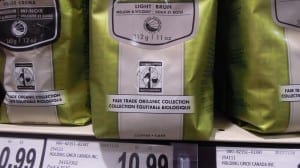The labour behind the (Fair Trade) label (2012)
Given my interest in fair trade coffee – as a brand and back story – I was interested to read an abstract for a recent research report entitled “The labour behind the (Fair Trade) label (2012).” The full reference is:
Eileen Davenport, Will Low, (2012) “The labour behind the (Fair Trade) label”, critical perspectives on international business, Vol. 8 Iss: 4, pp.329 – 348
The abstract reads:
Purpose
This paper critically examines the marketing of fair trade, arguing that the use of the term producer conflates a number of categories of actors, not all of whom benefit equally. The authors contend that the two existing archetypes – the noble peasant farmer and the independent artisan – and the emerging archetype of the “empowered decision maker” serve to obscure and mask complex labour relationships.
Design/methodology/approach
This conceptual paper draws on a wide range of literature and original fieldwork conducted by the authors to illustrate the three marketing archetypes in the fair trade value chain.
Findings
Hidden behind the three dominant archetypes used to promote fair trade is a relationship between fair trade “producers” (small farmer, craft enterprise and plantations) and permanent and temporary/casual labourers. The trickle-down of fair trade benefits to these workers is uneven at best and falls far short of the expectation of empowerment of all “producers” that fair trade promises.
Research limitations/implications
The fair trade project must look beyond the simple archetypes to engage more deeply with labour issues in the fair trade value chain, and to re-engage with fair trade as a development strategy through which broader and more complex forms of empowerment can be realised.
Practical implications
Fair trade standards are not a substitute for organised labour’s activities. Interactions between trade unions and fair trade bodies could ensure that existing labour standards are met, and improvements in the lives of all workers can occur.
Originality/value
This paper conceptualises three fair trade mainstream marketing archetypes and suggests why and how the fair trade movement must move beyond these to ensure empowerment amongst its least well-off stakeholders.
[End of abstract]
Fair Trade at Brock
A page at the Brock University website, conceding a September 2013 Fair Trade Campus Week, provides the following outline of what fair trade entails:
- During Fair Trade Campus Week in September 2013, Brock University became Canada’s sixth Fair Trade Campus – second in Ontario after Guelph – to be designated by Fairtrade Canada.
- The campus designation was made possible by the hard work of the Brock Fair Trade Club student group, and the University’s and Brock University Students’ Union’s (BUSU) food services operators.
- Initiated by BrockU students Anneka Bosse and Charissa DiMarco in 2011, the Brock Fair Trade club was created to raise awareness and educate the Brock community on fair trade issues at the University and in Niagara.
- What is fair trade?
- Fair trade is a market-based system that uses informed consumer support to influence international trade and business practices toward greater social and environmental sustainability. As a response to conventional trade systems, which have very often contributed to poverty and poor working conditions within developing countries, fair trade aims to build an alternative approach based on mutually beneficial relationships between producers and consumers.
The page also provides a link to a Sept. 24, 2013 Brock News article entitled: “Brock campus goes Fair Trade.”
Updates
A Huffington Post article, downloaded July 19, 2015, is entitled: The Myth of the Ethical Shopper. We’re still trying to eliminate sweatshops and child labor by buying right. But that’s not how the world works in 2015.
Also of interest: The Rebel Sell: How the Counterculture Became Consumer Culture (2004).
A Jan. 29, 2016 CBC article is entitled: “Coffee cups: 3 months later, are they being recycled at Tim Hortons and Starbucks?”


Leave a Reply
Want to join the discussion?Feel free to contribute!